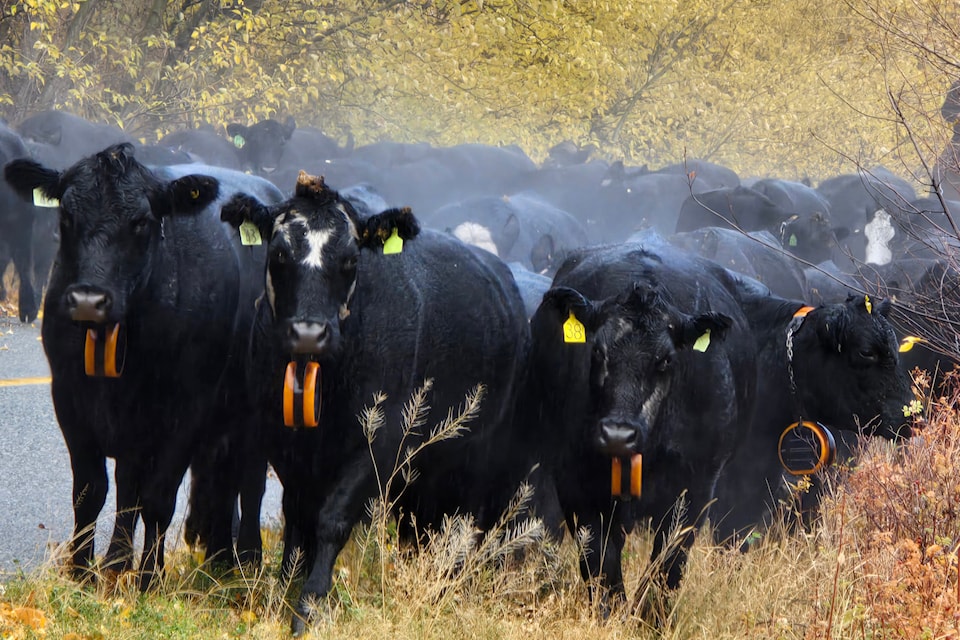When the cattle of Barrington Ranch made their return from grazing their annual cattle drive along River Road, a closer look may have revealed something new.
This year, the cattle that were released on Crater Mountain for the season weren't fenced in physically, instead, they were equipped with collars that used satellites and GPS to contain them.
That's because many of the fences, some anywhere from 50 to 60 years old, over the cattle's grazing range were destroyed in the 2023 Crater Creek Wildfire.
"The fire didn't burn everywhere on the mountain, but none of the fences are consistent from start to finish anymore," said rancher Christina Quaedvlieg. "The provincial range branch under the Ministry of Forestry came and said basically the cost of rebuilding those fences is prohibitive."
Replacing the fences wasn't an option, and neither was letting the cattle run loose, particularly with many areas still in the middle of recovery after the wildfire. The ranch began looking for other options, such as digital collars that had been used for operations in places like Alberta.
The mountainous terrain of the Similkameen and Okanagan Valleys posed far different challenges to the generally flat landscape of the Prairies, however.
Thomas Alexander, a family member who had been working on his Masters of Science at Thomspon Rivers University, was the one who provided the solution.
"When we started looking for collars, he was starting work on his dissertation on Gallagher collars so everything fell into place at the perfect time," said Quaedvlieg. "And, I would have to give credit to him in an article because Matt and I are 51 years old and we can get around technologically but when you start talking Starlink and all of the stuff up there that had to happen, that's where this kid comes in."
Barrington Ranch purchased 150 of the Gallagher collars and ended up selecting 142 of their cattle to send up to Crater Mountain to graze. With the collars, the ranchers were able to not only keep a constant eye on their location but also control where they were able to go.
Once they were out on the range, the cattle were rotated through different areas using the collars, something that wasn't possible before.
A small tower to broadcast the signal for the collars was set up where cell service dropped out, and it was hooked up to an RV Starlink receiver and a set of solar panels to make sure the entire mountain range was covered.
The Quaedvliegs were one of two ranches to trial the Gallagher collars, the other in Quebec that used them to move cattle between sections of a fenced grazing area and is one of the first to use any digital collars in mountainous terrain in Canada.
With only a slight hiccup where two of the cattle lost their collars briefly, the chains are designed to give way if they're snagged to avoid harming the animals, they've been thrilled with how well the collars have worked and are expecting them to become much more common across the province.
"We applied for more because it works so fantastic, we want to use it on some of our other ranges," said Quaedvlieg. "Gallagher, when they came to Canada, they put agents in Saskatchewan and Alberta because that's where most of the cows are, but now they seeing with the fires in British Columbia and the fence is burning, there's way more demand in BC than there is in Alberta or Saskatchewan."
Even with the modern innovation, the annual cattle drive back from Crater Mountain is a sign of the traditions that aren't going anywhere soon.
"We discussed this year about what we'd do because the corral burned. It's almost to the point where it's cheaper to load them into a trailer at the bottom of the mountain and haul them home," said Quaedvlieg. "But it's been a thing in Keremeos for so long, the people that are used to that cattle drive would crucify us. A month before we start getting calls and texts about when the cow drive is gonna (sic) happen."
When the cattle are due to return from ranging on the mountain, they're gathered up and taken along the Ashnola, stopping overnight at the campground, before being taken the rest of the way.
One of the trickiest parts is getting them across the bridge, which requires the cover of darkness and hay spread across the span to overcome their fear of the moving water.
"People this year were really excited to see it because a lot of locals knew that we had the collars on the cows," said Quaedvlieg. "The only other way to see them would have been to hike up the mountain."



